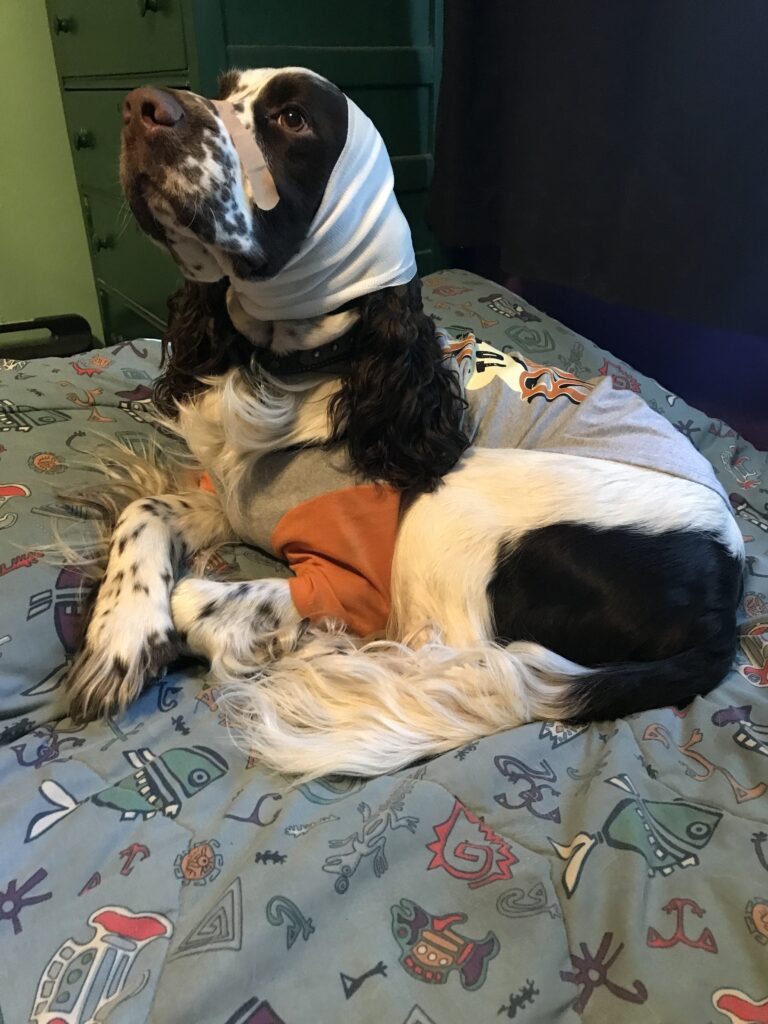Does time heal all wounds?
Physical wounds affect the body: cuts, bruises, broken bones, damage to internal organs. Behavior can be “wounded” also. As we’ve discussed here before, every experience a dog has affects his next experience. Fears can be created and developed. Stressful events can create anxieties that can generalize to other parts of a dog’s life. Chronic stress and conflicting inputs from humans can cause dogs to have a hard time learning the things humans want them to learn. Lack of appropriate socialization during puppyhood can result in “behavioral damage” in terms of fears, anxieties, and even phobias.

Both physical wounds and behavioral “wounds” can heal, but they don’t always. Sometimes physical wounds heal but leave scars. The healing of behavioral “wounds” almost always leaves pieces of unwanted behavior behind, documented by the work of R. J. Herrnstein on The Matching Law. Both physical and behavioral “wounds” are often dependent on positive input from humans to be made right because it’s the human world that dogs live their lives in.
Does time heal all wounds?
Let’s first consider physical wounds. Wound healing depends on the body’s immune system preventing infection and the circulatory system maintaining blood flow to nourish the local cells so they reproduce and create new tissue. These processes take time, but time is not what does the healing. If these body systems are not working, not doing their jobs properly, it doesn’t matter how long you wait – healing will not happen. The body’s systems need the support of a good diet, appropriate exercise and rest, and a stress-free environment to do their work properly.
With behavior problems, the concept is similar. Action is what makes the difference, but it takes time to learn how to apply the necessary actions and time for the dog to learn the new things that will help him. In addition, diet, exercise, rest, and a stress-free environment are key for keeping the dog healthy and making sure no additional behavior issues develop while interventions are made to change the current behavior problem.
Problems between dogs are heartbreaking
Consider a common behavior problem: a dog who feels threatened/stressed by other dogs. You can tell by reading the dog’s body language – avoiding the other dog, averting his eyes, maybe showing the whites of his eyes, tensing his body, and more. If the two dogs who are having trouble getting along both live in your home, life becomes a little more challenging for everyone in the home. Being able to read these subtle signs of stress/anxiety/fear is essential for dog owners to understand what’s going on. Our Dog Reading Course can help.
Time does not heal all wounds
People often ask, “Won’t he grow out of it?” or “Maybe the dogs just need time?” It would be nice if the dogs would solve the problem themselves, but without human intervention, it’s possible the problem not only won’t get better but may actually get worse.
It’s what you do with the time that matters.
Over time, the dogs will certainly figure out how to live together, but there may be fights, there will certainly be stress, and the solutions they come up with may not include being friendly with each other or even being comfortable with each other’s presence. You see, dogs do what works for them in the moment. They learn from every single experience what to try next time and what not to try. Unless the humans set things up so the dogs feel safe and secure and they have a repertoire of good choices at hand, harmony will not be the description of your living conditions with these dogs. Time doesn’t heal; human interventions, applied over time, do.
Taking action to make changes
What actions can you take? Ideally, you follow the guidelines in our Introducing Dogs and Multiple Dog Household blog posts. Those resources will guide you to set up your home environment in a way that works to facilitate great relationships between dogs, even between dogs and cats.
A common theme throughout these resources is you being able to observe what is really going on between the dogs, as well as with each dog separately. Resist the urge to let the pets “work things out” because they may do so in a way that is not sustainable for you or for themselves. The last thing you want is a houseful of pets who are afraid of each other, avoid each other, or even worse, attack each other on a regular basis.
Specific actions you can take
- Body Language: Learn what information dogs are giving you.
- Introduce or Re-introduce 2 pets to each other: They must both feel safe, be able to escape if they feel the need, and perceive the experience as a good one. Pair the presence of another pet with positive things like treats. Classical Conditioning is your friend in these endeavors.
- Alone Time: Provide time to fully relax between introduction sessions – yes, there should be multiple sessions.
- Barriers for Physical and Emotional Protection: Use the variety of baby gates and other types of barriers available to aid your process. Even leashes, as long as you keep the leashes loose to ensure positive associations.
- Space/Distance Between Animals: Always provide space, whatever it takes. You may have to guide a dog in walking past another dog if he doesn’t naturally give a wide berth, because the other dog is likely to feel threatened by him walking right by his face. Treats are your friend in these instances: both dogs get a series of treats as one dog passes and the other stays in place.
- Feeding: Feed dogs in separate rooms with physical walls and doors between them to help them feel safe during a vulnerable time.
- Sleeping: Provide nighttime sleeping areas where the dogs are not able to get up in the middle of the night and bother each other at a time when you are unaware and unable to intervene.
- Crating: If you crate dogs, be sure to protect a crated dog from being approached by a loose dog; especially if he has already shown some concern about being approached by dogs. Imagine being inside a crate with no option to get away, while other dogs are able to come up to every side of the crate and poke their noses in! Remember, for the crated dog, approaching dogs feel threatening even if they don’t mean to be.
What else can you do?
Once a problem between dogs emerges, if you are a foster home, it interferes with your ability to bring more dogs in. It’s best to not bring more dogs in until you’ve solved the problem. If you have a dog in your home who feels threatened by other dogs, he needs you to minimize the number of dogs he’s exposed to until he can handle things better. It’s likely he’ll need to be completely separated from other dogs at first and then re-introduced to start over again with calmer emotions and better behavior.
Above all, be sure to set up situations in which you can associate the presence of another dog with good things. It’s not enough for “nothing bad to happen.” We can truly teach dogs through association when we provide opportunities for him to make really great associations. Your job is to create an environment where: when a dog is present, really good things happen; when no dog is around, life is boring.
Of course, training is available to help you through The Mannerly Dog.
Today is the first day of the rest of your life
Start out right with a new dog or start now to transform your life with that of the dog you’ve loved for a while. Part of “starting out right” is providing opportunities for a dog to make good associations between things that could easily be scary and good things like treats. This is one of the ways treats are such wonderful training tools. You truly have the power to change a dog’s emotional reaction to another dog from something like, “Help! A dog! Get away from me!” to “Hey, there’s a dog! Cool!” In training circles, this is known as a conditioned emotional response (CER).
That’s your “training secret” for today. Just kidding; there are no training secrets. You can learn behavior science just as easily as anyone else if you’re interested. But it takes action to learn something new. Time doesn’t change things – the right actions do.


